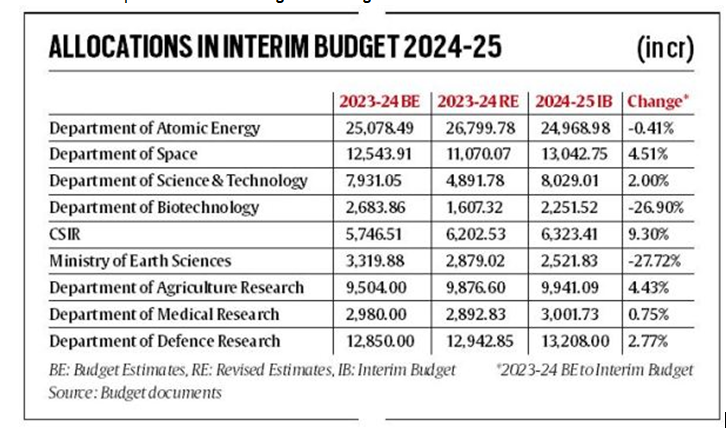

Context
India celebrates National Science Day on 28th February every year. The theme for the year 2024 is ‘Science for Sustainable Development’, which highlights the role of science in making India a developed country by 2047.
So, let us understand the role of science in achieving India’s ambitions.
Dimension 1: The Potential of growth in the field of Science and Technology in India:
- Science and Technology hold the key to the progress and development of any nation.
- Technology plays a fundamental role in wealth creation, improvement of the quality of life, and real economic growth and transformation in any society.
- Science and technology have created the development of nations and societies that are all proportional to each other.
- Advances in science and technology facilitate higher yields, greater efficiency, and greater nutritional content.
- Advances in scientific knowledge and its application helped to slow the trend of high fertility, and high mortality and led to increasingly better health for people in India.
- Science and technology provide the basis for improvements in human health by the introduction of technologies in medical facilities.
|
Present Developments in the field of Science and Technology in India:
|
Dimension 2 :Why growth in the field of science is affected?
- Lesser budgetary Support: India’s R&D expense has dropped to the current64% of GDP from 0.8% in 2008-2009.
|
Most developed countries spend between 2% and 4% of their respective GDPs on R&D. |
- Under-utilisation of Funds: The Union Ministry of Science and Technology has consistently under-utilized its budget.
- Inadequate management of Departments: In 2022-2023, the Department of Biotechnology (DBT), used only 72% of its estimated budget allocation on Centrally Sponsored Schemes/Projects while the Department of Science and Technology (DST) used only 61%.
- Comparison with developed countries: India currently spends just about 0.65% of its national GDP on research and development activities. The global average is about 1.8%.
Dimension 3: Challenges associated with lack of funding
- Lesser motivation for researchers/scientists: Researchers face a struggle to secure and sustain funding. While the scientific workforce is increasing, funding has been on a decline over the past decade.
- The situation is particularly perilous for early career researchers who find it hard to compete for funds with senior researchers.
- No diversification of fields of research: Researchers and funding bodies are reluctant to invest their resources in replication studies due to high investment results.
- Demotivated emerging ideas and talents: Scientific research typically requires expensive equipment, manpower, and significant financial investment, and they need to compete for funding support from the government, corporations, and foundations to conduct their research.
- Lesser pace for outcomes: Due to a lack of infrastructure and funding, the models prepared by scientists or researchers may face hurdles to reach the final stage and time can also be wasted for that reason.
Dimension 4: Impacts:
- Low developments for cost-efficient technologies for Agriculture and Societal benefits.
- More reliance on imports and thus a stake in the ‘Make in India’ initiative.
- Complicated models/structures for common people which launched in the markets can cause failures for emerging Entrepreneurs.
- Drawback for local businesses and trades.
- Less confidence at the world level for Indian research models.
- Ultimately lesser pace of development in local areas due to lack of funds.
Dimension 5: Role of Science and Technology in Economic Growth:
In economics, it is widely accepted that technology is the key driver of the economic growth of countries, regions and cities. Technological progress allows for the more efficient production of more and better goods and services, which is what prosperity depends on. The role of technology in economic development can be summarised as follows:
- Efficiency: Technology can contribute to the efficiency of a business's output rate, allowing for larger quantities of products to be moved or of services to be rendered.
- Specialization: Technology has to lead to an increase in the division of labour and specialization of jobs within a business, further contributing to the efficiency with which a business can run.
- Natural Resources: Technology has a huge effect on the ability of businesses and governments to access natural resources and use them in the most effective ways possible to benefit both the business and the economy.
- Industrial Expansion: Thanks to the increased efficiency of labour with the ever-improving state of technology, businesses can increase total output, which in turn leads to higher profits and greater economic development.
- Research: Better technology has led to further research into nearly every sector of business and science, meaning businesses can benefit from all sorts of technological advancements.
- The Internet and International Trade: Information technology is the single most important element in the success and growth of international trade and job market growth, allowing businesses to share information and conduct trade in less time than the blink of an eye.
Dimension 6: Required Measures
- To avoid inadequate R&D Spending: There is a need to allocate at least 3% of the GDP annually until 2047.
- Decrease dependency on Public Funding: India's reliance on public money for R&D is highlighted as a sign of an immature financing system and a weak domestic market, with the private sector contributing only 4% in 2020-2021.
- To overcome private Sector hesitancy: The private sector's reluctance to invest in R&D in India is attributed to factors such as a poor capacity to evaluate R&D, unclear regulatory roadmaps, lack of clear exit options (especially in biotechnology), and concerns about intellectual property rights theft.
Conclusion
India needs the bureaucratic capacity to evaluate science projects and, after allocations, monitor utilization. Building such capacity is a prerequisite for India becoming a science power by 2047.



